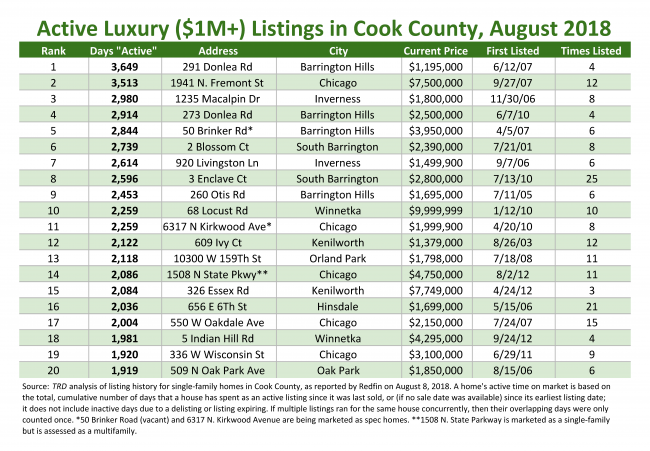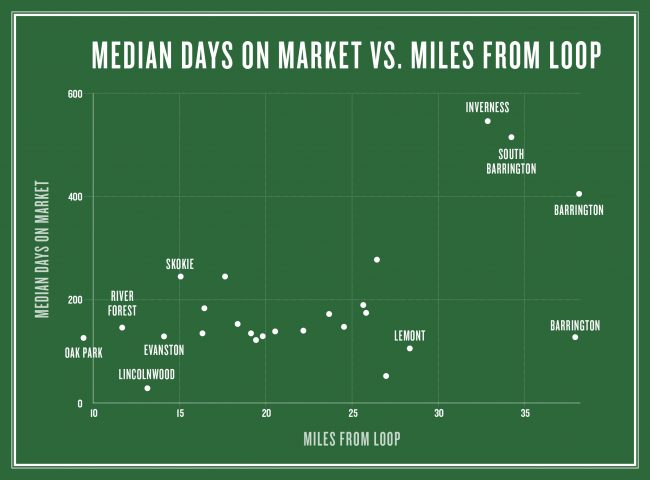A Barrington Hills home priced at $1.2 million has sat on the market for over a decade. The same for a 10,000-square-foot Chicago estate, which now lists at $7.5 million. And in Kenilworth, a 4.5-bedroom house on the market for around $1.4 million just recently passed its 15th year without a sale.
The whims of homebuyers have never been easy to predict, but now, as record luxury home construction lets air out of Chicago’s high-end housing market, brokers are trying harder than ever to tether sellers’ expectations to reality.
And the data supports their strategy.
In Cook County, 17 single-family homes priced above $1 million have spent more than 2,000 days each on the market, according to an analysis by The Real Deal of Redfin listings. During that time, some of the homes have been taken out of public view and re-listed more than 20 times, which can make them more attractive to potential buyers.
Chicago’s luxury home glut has turned “long market time,” a three-word albatross feared by sellers everywhere, into an increasingly unavoidable hazard for brokers to navigate.
Jeff Lowe, a Compass agent and Chicago’s top broker by volume last year, said of the phenomenon: “You’re still paying your water bill and your tax bill, and it’s nerve-racking to be sitting on an empty house month after month.” He added, “it’s just a drag.”
Even Chicago Bulls legend Michael Jordan is not immune. Jordan’s 30,000-square-foot Highland Park estate has become a monument to long market time: It was first listed in 2012.
But a turnaround is possible. And while Lowe said some brokers “don’t like to have that serious conversation with sellers” about price cuts or upgrades, the slowdown in the luxury market is “starting to get through to them now.”
Experienced agents have spent their careers figuring out how to bring fresh eyes to homes that have gone stale on the Multiple Listings Service, whether it’s through new marketing, cosmetic re-tooling or a targeted price cut. Otherwise, there’s nothing to do but wait.
Adding a modern touch
Before Lowe suggests a price mark-down for a property that’s been languishing on the market, he considers minor rehabs that could woo a larger share of the high-end buyers, he said.
“You can paint a whole kitchen for $7 or $8,000, prevent someone from wanting to rip out all the cabinets, and you can keep that price a little higher,” he said.
Lowe will also suggest replacing wood floors and beige finishes with more contemporary-looking grays and whites wherever possible. Even replacing watercolor paintings with black-and-white photo prints could make the place look more modern, he said.
Scouting out makeovers is also usually the first move for Jenny Ames, a Coldwell Banker agent who was among the city’s top-selling brokers by sales volume last year.
Ames was recently hired to sell a property with “black linoleum floors, clouds painted on the ceilings and grandma’s antiques,” Ames said. “I told them their price was fine, but not the way it looks now.”
The family put $12,000 into renovations, and Ames re-listed it at the same price as before, she said. Within two days, she had three offers.
“It seems like fewer people these days want to roll up their sleeves and renovate,” Ames said. “But I tell people that every dollar they spend on staging will come back four times — it seems like common sense, but you’d be surprised by how many people don’t have the patience for it.”
Anxious sellers facing sluggish demand often have no choice but to take a hatchet to their asking price, but deciding how big a piece to chop off can be much harder. Ames compared it to fishing.
“You have to cast where the fish are, and that’s how I think about pricing,” she said. “And it can be a challenge on the high end of the market, because you often don’t have enough data to know where the fish are.”
But when it’s time to re-list with a lower price, Ames always suggests a markdown between 5 and 10 percent — enough to “reset the market” of potential buyers.
“For a price change to be effective, you need to show that you’re picking up your toys and moving to a whole new sandbox,” Ames said. “If you’re priced at $5 million and you bring it down by $125,000, to me that’s a sign that the seller isn’t credible.”
Riding it out
Other luxury sellers are more patient, and brokers find ways to accommodate them.
Jim Kinney, a Gold Coast-based broker with Baird & Warner, said wealthy sellers sometimes intentionally come out of the gate with an above-market price.
“Some people price it for that one person out there they think would pay a premium,” Kinney said. “And you never know — there’s a P.T. Barnum born somewhere every minute.”
One of Kinney’s clients insisted on a high price for his home on State Parkway and didn’t budge for two years, he said. Other homeowners, with even more time to spare, have kept their houses off active listings until the surrounding market caught up to their desired price.
The sit-and-wait strategy presents risks, but it could be the right move for some homes, Ames said.
“Typically long market time suggests there’s a significant problem with the pricing or presentation, but at some price points in this market, it’s just the new normal,” she said. “If you have an $8 million home in the Gold Coast that was built in the 1880s, the market could take a while to find someone who’s really going to appreciate that classic architecture.”
Coming prepared
Technological leaps have sharpened the consequences of long market time and made it harder to play games with active listings, according to Patrick Ryan, Related Realty’s managing broker.
A decade ago, it was easy enough for sellers to obscure how long their home had been on the market, Ryan said. They could remove their listings and repost them, or even lie. But every year, new analytical trackers put more aspects of each parcel’s history within arms’ reach of homebuyers.
“Right now I can pull out my phone and pull up the average market time for every home in the city by price, by block, by building type,” Ryan said. “If I’m a buyer and I can tell something’s been on the market longer than it should have, I’m going to use that against you in negotiations.”
Nowadays, before Related brokers blast a property onto listing services, they take at least three weeks to stage and re-light the home, Ryan said. They dive into sales data to research an appropriate price. They ask if sellers can hold off until spring or early summer, when buyers are busiest.
“One of the things I think we could do better in residential real estate is to slow down and be patient, to approach everything with a consultant’s mindset,” Ryan said. “Because the moment you put something on the MLS, the clock starts ticking. And if you don’t have everything in order, it can start to hurt you.”
Sweetening the pot
Lowe is well-practiced in all the conventional ways brokers try to escape long market time — re-staging, renovations, price drops, new photography — but this year, he tried something new.
At the beginning of August, Lowe and his team offered bonuses between $5,000 and $25,000 to brokers whose clients buy any of 28 properties Lowe had listed. Five of the properties sold, and Lowe dispersed $50,000 among the buyers’ agents.
The sweetener was designed to “get other brokers on [his] radar,” he said. It worked, boosting his showing traffic by 30 percent over last August, a characteristically slow month for home sales. Lowe said he plans to offer the same bonus program next August.
“At the end of the day, you can’t control whether someone’s going to want to buy a home,” he said. “But you can do a lot to get more people in the front door.”


